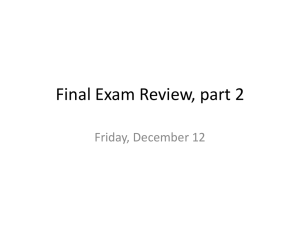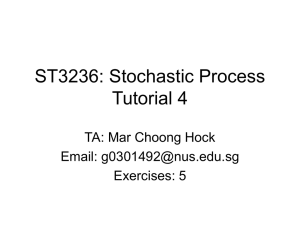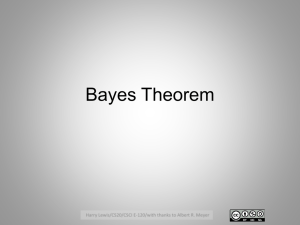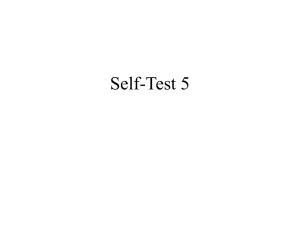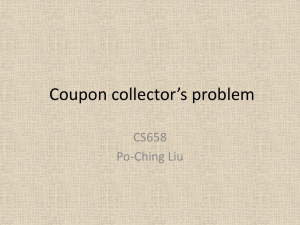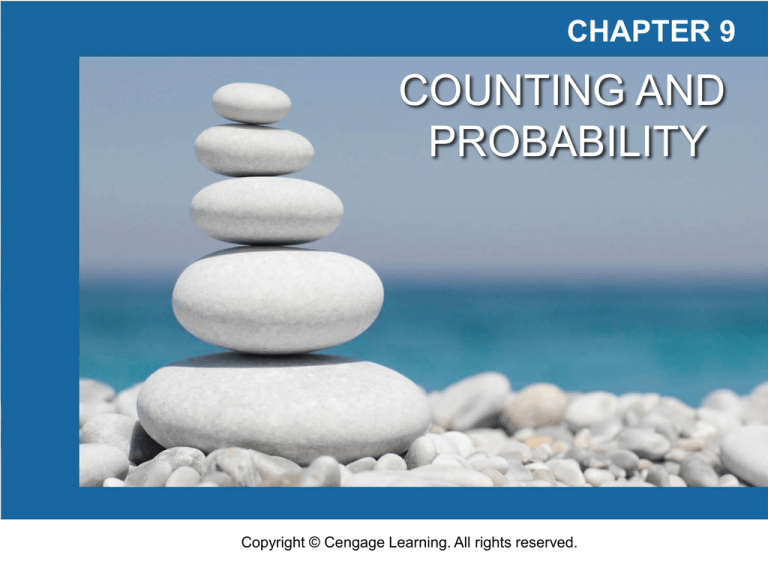
CHAPTER 9
COUNTING AND
PROBABILITY
Copyright © Cengage Learning. All rights reserved.
SECTION 9.9
Conditional Probability, Bayes’
Formula, and Independent Events
Copyright © Cengage Learning. All rights reserved.
Conditional Probability, Bayes’ Formula, and Independent Events
In this section we introduce the notion of conditional
probability and discuss Bayes’ Theorem and the kind of
interesting results to which it leads.
We then define the concept of independent events and give
some applications.
3
Conditional Probability
4
Conditional Probability
Imagine a couple with two children, each of whom is
equally likely to be a boy or a girl. Now suppose you are
given the information that one is a boy. What is the
probability that the other child is a boy?
Figure 9.9.1 shows the four equally likely combinations of
gender for the children.
Figure 9.9.1
5
Conditional Probability
You can imagine that the first letter refers to the older child
and the second letter to the younger.
Thus the combination BG indicates that the older child is a
boy and the younger is a girl.
The combinations where one of the children is a boy are
shaded gray, and the combination where the other child is
also a boy is shaded blue-gray.
Given that you know one child is a boy, only the three
combinations in the gray region could be the case, so you
can think of the set of those outcomes as a new sample
space with three elements, all of which are equally likely.
6
Conditional Probability
Within the new sample space, there is one combination
where the other child is a boy (in the region shaded
blue-gray).
Thus it would be reasonable to say that the likelihood that
the other child is a boy, given that at least one is a boy, is
1/3 = 33 %.
Note that because the original sample space contained four
outcomes,
also.
7
Conditional Probability
A generalization of this observation forms the basis for the
following definition.
Note that when both sides of the formula for conditional
probability (formula 9.9.1) are multiplied by P(A), a formula
for P(A B) is obtained:
8
Conditional Probability
Dividing both sides of formula (9.9.2) by P(B | A) gives a
formula for P(A):
9
Example 2 – Representing Conditional Probabilities with a Tree Diagram
An urn contains 5 blue and 7 gray balls. Let us say that 2
are chosen at random, one after the other, without
replacement.
a. Find the following probabilities and illustrate them with a
tree diagram: the probability that both balls are blue, the
probability that the first ball is blue and the second is not
blue, the probability that the first ball is not blue and the
second ball is blue, and the probability that neither ball is
blue.
b. What is the probability that the second ball is blue?
10
Example 2 – Representing Conditional Probabilities with a Tree Diagram
cont’d
c. What is the probability that at least one of the balls is
blue?
d. If the experiment of choosing two balls from the urn were
repeated many times over, what would be the expected
value of the number of blue balls?
Solution:
Let S denote the sample space of all possible choices of
two balls from the urn, let B1 be the event that the first ball
is blue, and let B2 be the event that the second ball is blue.
11
Example 2 – Solution
Then is the event that the first ball is not blue and
the event that the second ball is not blue.
cont’d
is
a. Because there are 12 balls of which 5 are blue and 7 are
gray, the probability that the first ball is blue is
and the probability that the first ball is not blue is
12
Example 2 – Solution
cont’d
If the first ball is blue, then the urn would contain 4 blue
balls and 7 gray balls, and so
where
is the probability that the second ball is
blue given that the first ball is blue and
is the
probability that the second ball is not blue given that the
first ball is blue.
13
Example 2 – Solution
cont’d
It follows from formula (9.9.2)
that
and
14
Example 2 – Solution
cont’d
Similarly, if the first ball is not blue, then the urn would
contain 5 blue balls and 6 gray balls, and so
where
is the probability that the second ball is
blue given that the first ball is not blue and
is
the probability that the second ball is not blue given that
the first ball is not blue.
15
Example 2 – Solution
cont’d
It follows from formula (9.9.2) that
and
16
Example 2 – Solution
cont’d
The tree diagram in Figure 9.9.2 is a convenient way to
help calculate these results.
Figure 9.9.2
17
Example 2 – Solution
cont’d
b. The event that the second ball is blue can occur in one
of two mutually exclusive ways: Either the first ball is
blue and the second is also blue, or the first ball is gray
and the second is blue. In other words, B2 is the disjoint
union of B2 B1 and B2 .
Hence
18
Example 2 – Solution
cont’d
Thus the probability that the second ball is blue is 5/12,
the same as the probability that the first ball is blue.
c. By formula 9.8.2, for the union of any two events,
19
Example 2 – Solution
cont’d
Thus the probability is 15/22, or approximately 68.2%,
that at least one of the balls is blue.
20
Example 2 – Solution
cont’d
d. The event that neither ball is blue is the complement of
the event that at least one of the balls is blue, so
21
Example 2 – Solution
cont’d
The event that one ball is blue can occur in one of two
mutually exclusive ways: Either the second ball is blue and
the first is not, or the first ball is blue and the second is not.
Part (a) showed that the probability of the first way is
and the probability of the second way is also .
,
Thus, by probability axiom 3,
22
Example 2 – Solution
cont’d
Finally, by part (a),
Therefore,
23
Bayes’ Theorem
24
Bayes’ Theorem
Suppose that one urn contains 3 blue and 4 gray balls and
a second urn contains 5 blue and 3 gray balls. A ball is
selected by choosing one of the urns at random and then
picking a ball at random from that urn. If the chosen ball is
blue, what is the probability that it came from the first urn?
This problem can be solved by carefully interpreting all the
information that is known and putting it together in just the
right way.
Let A be the event that the chosen ball is blue, B1 the event
that the ball came from the first urn, and B2 the event that
the ball came from the second urn.
25
Bayes’ Theorem
Because 3 of the 7 balls in urn one are blue, and 5 of the 8
balls in urn two are blue,
And because the urns are equally likely to be chosen,
26
Bayes’ Theorem
Moreover, by formula (9.9.2),
But A is the disjoint union of (A B1) and (A B2), so by
probability axiom 3,
27
Bayes’ Theorem
Finally, by definition of conditional probability,
Thus, if the chosen ball is blue, the probability is
approximately 40.7% that it came from the first urn.
The steps used to derive the answer in the previous
example can be generalized to prove Bayes’ Theorem.
28
Bayes’ Theorem
29
Example 3 – Applying Bayes’ Theorem
Most medical tests occasionally produce incorrect results,
called false positives and false negatives.
When a test is designed to determine whether a patient has
a certain disease, a false positive result indicates that a
patient has the disease when the patient does not have it.
A false negative result indicates that a patient does not
have the disease when the patient does have it.
30
Example 3 – Applying Bayes’ Theorem cont’d
When large-scale health screenings are performed for
diseases with relatively low incidence, those who develop
the screening procedures have to balance several
considerations: the per-person cost of the screening,
follow-up costs for further testing of false positives, and the
possibility that people who have the disease will develop
unwarranted confidence in the state of their health.
Consider a medical test that screens for a disease found in
5 people in 1,000. Suppose that the false positive rate is
3% and the false negative rate is 1%.
31
Example 3 – Applying Bayes’ Theorem cont’d
Then 99% of the time a person who has the condition tests
positive for it, and 97% of the time a person who does not
have the condition tests negative for it.
a. What is the probability that a randomly chosen person
who tests positive for the disease actually has the
disease?
b. What is the probability that a randomly chosen person
who tests negative for the disease does not indeed have
the disease?
32
Example 3 – Solution
Consider a person chosen at random from among those
screened. Let A be the event that the person tests positive
for the disease, B1 the event that the person actually has
the disease, and B2 the event that the person does not
have the disease.
Then
Also, because 5 people in 1,000 have the disease,
33
Example 3 – Solution
cont’d
a. By Bayes’ Theorem,
Thus the probability that a person with a positive test
result actually has the disease is approximately 14.2%.
34
Example 3 – Solution
cont’d
b. By Bayes’ Theorem,
Thus the probability that a person with a negative test
result does not have the disease is approximately
99.995%.
35
Example 3 – Solution
cont’d
You might be surprised by these numbers, but they are
fairly typical of the situation where the screening test is
significantly less expensive than a more accurate test for
the same disease yet produces positive results for nearly
all people with the disease.
Using the screening test limits the expense of
unnecessarily using the more costly test to a relatively
small percentage of the population being screened, while
only rarely indicating that a person who has the disease is
free of it.
36
Independent Events
37
Independent Events
For instance, A is the event that a head is obtained on the
first toss and B is the event that a head is obtained on the
second toss, then if the coin is tossed randomly both times,
events A and B should be independent in the sense that
P(A | B) = P(A) and P(B | A) = P(B).
To obtain the final form for definition of independence,
observe that
38
Independent Events
By the same argument,
Conversely
and
39
Independent Events
Thus, for convenience and to eliminate the requirement
that the probabilities be nonzero, we use the following
product formula to define independent events.
40
Example 6 – Computing Probabilities of Intersections of Two Independent Events
A coin is loaded so that the probability of heads is 0.6.
Suppose the coin is tossed twice. Although the probability
of heads is greater than the probability of tails, there is no
reason to believe that whether the coin lands heads or tails
on one toss will affect whether it lands heads or tails on the
other toss. Thus it is reasonable to assume that the results
of the tosses are independent.
a. What is the probability of obtaining two heads?
b. What is the probability of obtaining one head?
41
Example 6 – Computing Probabilities of Intersections of Two Independent Events
cont’d
c. What is the probability of obtaining no heads?
d. What is the probability of obtaining at least one head?
Solution:
The sample space S consists of the four outcomes
{HH, HT, TH, TT }, which are not equally likely.
Let E be the event that a head is obtained on the first toss,
and let F be the event that a head is obtained on the
second toss. Then P(E) = P(F) = 0.6, and it is to be
assumed that E and F are independent.
42
Example 6 – Solution
cont’d
a. The probability of obtaining two heads is P(E F).
Because E and F are independent,
43
Example 6 – Solution
cont’d
b. One head can be obtained in two mutually exclusive
ways: head on the first toss and tail on the second, or tail
on the first toss and head on the second.
Thus, the event of obtaining exactly one head is
(E ) ( F). Also (E ) ( F) = ∅, and,
moreover, by the formula for the probability of the
complement of an event, P( ) = P( ) = 1 – 0.6 = 0.4.
Hence
44
Example 6 – Solution
c. The probability of obtaining no heads is
cont’d
.
45
Example 6 – Solution
cont’d
d. There are two ways to solve this problem. One is to
observe that because the event of obtaining one head
and the event of obtaining two heads are mutually
disjoint,
The second way is to use the fact that the event of
obtaining at least one head is the complement of the
event of obtaining no heads.
46
Example 6 – Solution
cont’d
So
47
Independent Events
For instance, we say three events A, B, and C are pairwise
independent if, and only if,
The next example shows that events can be pairwise
independent without satisfying the condition
P(A B C) = P(A) P(B) P(C).
Conversely, they can satisfy the condition
P(A B C) = P(A) P(B) P(C) without being pairwise
independent.
48
Independent Events
Four conditions must be included in the definition of
independence for three events.
49
Independent Events
The definition of mutual independence for any collection of
n events with n 2 generalizes the two definitions given
previously.
50
Example 9 – Tossing a Loaded Coin Ten Times
A coin is loaded so that the probability of heads is 0.6 (and
thus the probability of tails is 0.4). Suppose the coin is
tossed ten times. As in Example 6, it is reasonable to
assume that the results of the tosses are mutually
independent.
a. What is the probability of obtaining eight heads?
b. What is the probability of obtaining at least eight heads?
51
Example 9(a) – Solution
For each i = 1, 2, . . . , 10, let Hi be the event that a head is
obtained on the ith toss, and let Ti be the event that a tail is
obtained on the ith toss.
Suppose that the eight heads occur on the first eight tosses
and that the remaining two tosses are tails. This is the
event
H1 H2 H3 H4 H5 H6 H7 H8 T9 T10.
For simplicity, we denote it as HHHHHHHHTT. By
definition of mutually independent events,
52
Example 9(a) – Solution
cont’d
Because of the commutative law for multiplication, if the
eight heads occur on any other of the ten tosses, the same
number is obtained.
For instance, if we denote the event
H1 H2 T3 H4 H5 H6 H7 H8 T9 H10 by
HHTHHHHHTH, then
53
Example 9(a) – Solution
cont’d
Now there are as many different ways to obtain eight heads
in ten tosses as there are subsets of eight elements (the
toss numbers on which heads are obtained) that can be
chosen from a set of ten elements.
This number is
. It follows that, because the different
ways of obtaining eight heads are all mutually exclusive,
54
Example 9(b) – Solution
cont’d
By reasoning similar to that in part (a),
and
55
Example 9 – Solution
cont’d
Because obtaining eight, obtaining nine, and obtaining
ten heads are mutually disjoint events,
56
Independent Events
Note the occurrence of the binomial coefficients
in
solutions to problems like the one in Example 9. For that
reason, probabilities of the form
where 0 p 1, are called binomial probabilities.
57



